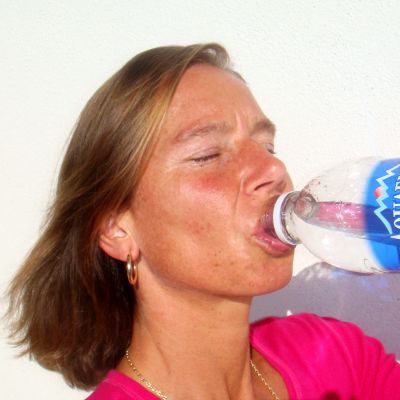With bottled water a multi-billion dollar industry, it would be easy to assume that Americans are thoroughly hydrated. The truth is dehydration is a common problem.
As much as 75 percent of the human body is water. Maintaining levels requires one to three liters of water daily. But even those who are sedentary need water because our bodies lose moisture continually – through urination, elimination of waste and toxins, sweating and even breathing. Many believe that chronic, low-grade dehydration is common place. Lack of sufficient fresh, clean water not only results in a long list of symptoms, but it also can be fatal.
Urine color is a good indicator of hydration. Ideally, urine should be colorless. Bright yellow to orange urine indicates too little water in the body. The only exception to this is that certain water-soluble vitamins, including C and B complex, may temporarily turn urine a bright yellow.
Other factors contributing to dehydration is dry mouth, hunger, fatigue, muscle cramps, brain fog, depression, anxiety, rapid heartbeat, nausea or vomiting and pain. So many people opt for super drinks, pain relievers and other ineffective remedies instead of reaching for a glass of water. Eating processed food, drinking a sugary beverage or taking a pain remedy when your body needs water only makes the dehydration worse, creating a vicious cycle.
The Standard American Diet (SAD) is high in a type of refined salt called sodium chloride, or common table salt. Unlike unrefined salt, which is a vitally important nutrient, sodium chloride is actually a toxin. Eating the processed foods found in the typical American diet translates into a whopping 4,000 to 6,000 mg of sodium chloride a day. That`s a very heavy toxic load for the body to deal with. Thus, the body wastes enormous amounts of water to counteract the toxic effects. So water that should be going to the cells and body`s organs is being diverted to cleaning up the sodium chloride. Kidney and gall stones, bloating from water retention, painful joints and other health issues are a direct result of sodium chloride consumption.
Many try to quench their thirst at the nearest vending machine, juice bar or coffee shop. It might seem like these other liquids would be just as hydrating as water, but that`s not the case. Guzzling soda, beer, coffee, tea or juice acts as a diuretic, removing water from the body faster than it normally would be eliminated.
To hydrate invest in a water ionizer/filtration system with a choice of pH levels or purchase a simple water filter to make sure the water you`re drinking is as clean and fresh as possible. Glass containers or stainless steel bottles are healthier than ordinary plastic water bottles. Drink 16 oz of water between breakfast and lunch and another 16 oz between lunch and dinner.
Pay attention to (signs). Symptoms like hunger, headaches, muscle cramps, heartburn and fatigue are frequently signs of thirst. Drink a glass of water, and then wait ten minutes to see if you feel better.
Stop consuming processed foods in order to reduce sodium chloride intake. Use as little unrefined salt as possible while cooking.
Enhance hydration by eating water producing vegetables and fruits.
Enjoy a cup of coffee or tea, cocktail or glass of wine with a glass of pure water to offset the diuretic effects of the alcohol or caffeine.
If water seems bland then try adding a touch of flavor. Wedges of watermelon, a slice of lemon or lime and a chunk of cucumber are all tasty additions to water with none of the side effects of sodas.
by: Leigh Erin Connealy, M.D.
Source: http://www.naturalnews.com/


